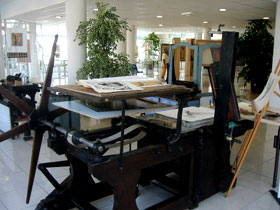Les 12 gravures
Moses exposed on the Nile or Moses abandoned
The abandonment of Moses
Finding of Moses
Moses saved from the waters
Moses saved from the waters
Moses trampling the crown of the Pharaoh
Moses changing his rod into a serpent
Moses changing his rod into a serpent
The Adoration of the Golden Calf
Striking the rock
The Israelites gathering manna
The Crossing of the Red Sea

© Droits Réservés
Like the History of Moses tapestry, these 12 engravings were all copied from the eight paintings by Poussin.
Have a stroll around the room and take a good look at them all.
Engraving is a technique of reproduction developed from the 15th century onwards in France, which played an important role in the circulation of images. First used by craftsmen, notably goldsmiths and printers, it gradually became a means of artistic expression in its own right, with a range of diverse techniques. Many artists appreciated the freedom offered by these techniques, and that is why the process is still practised today.
In the 17th century, engravings and tapestries occupied an important place in the dissemination of the paintings of great masters such as Poussin.
In 1667, Louis XIV created a workshop of "engravers in ordinary to the king", under the authority of Charles Le Brun. The workshop was to supply engravings on copper which recorded the important events of the reign but above all to reproduce all the works belonging to the collections of the Crown.
In 1670, at the request of Colbert, all these engravings were put together in a series of collections known as the Cabinet du Roi. These volumes were intended to be presented as gifts to members of the court and ambassadors of foreign courts. Such a prestigious gift contributed as much to circulating the works of masters as to the glory of the monarch. This first wave of circulation was followed by the development of marketing engravings to the general public, which proved very popular.
